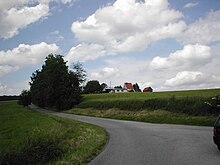Ursenbacherhof (Waibstadt)
The Ursenbacherhof , formerly also called the Bleihof , is a historic farm near Daisbach , a district of Waibstadt in the Rhein-Neckar district in northern Baden-Württemberg .
location
The Ursenbacher Hof is surrounded by open land about 1.5 km southwest of the center of Daisbach on a southern hill spur above the Ursenbach , which drains into the Elsenz via another stream 2.2 km further to the southwest in Hoffenheim . To the west of the farm, after about 600 m, the Great Forest begins , which stretches down to Elsenz, and to the south-west of it after about 700 m, the Orles Forest . A group of farms is located on the access road from Daisbach about 600 m north of the farm.
history
The exact date of the establishment of the farm is unknown. Local researchers suspect that the Ursenbacherhof was already one of the goods not listed by name, which is mentioned in a deed of foundation by the Speyer bishop Johannes , who furnished the Benedictine monastery in Sinsheim with numerous goods on January 6, 1100 . In any case, an old ring wall of the Sinsheimer Stift from the time of the monastery foundation has the same structural features as the former walling of the courtyard.
The area around the court was initially owned by various counts and noblemen. In the 14th century the farm was owned by the Sinsheim monastery; the literature suggests that the court, like the neighboring settlement of Breitenhart , which had passed away , could have come to the monastery as a legacy of a knight who did not return from a crusade. In 1496, Bishop Ludwig von Speyer approved the sale of the farm and other surrounding properties to the monastery, which had meanwhile been converted into a monastery. Possibly the court came to Matthias von Rammung, nephew of the Speyer bishop of the same name , and his wife Ursula. The farm and the nearby Orleswald could then have returned to the Sinsheim monastery as a foundation of the old Orschel ( Ursula von Rammung , † 1502), which owned the farm again in 1565, at that time already leased to leaseholders for several decades. In 1601 the courtyard was renewed, which was once shown by building inscriptions. During the Thirty Years' War the farm was temporarily idle before leaseholders took over the management again from 1653. The landlord was the Electoral Palatinate , whose property was managed by the Hilsbach winery . In 1848 the long lease was replaced and the existing tenants became owners.
The yard was also called the lead yard because hemp was bled there , i. H. was broken . An old oak fountain near the courtyard once fed the Bleihöfer Lake , which was filled in in the 1960s with the rubble of the old Ursenbacherhof buildings that had been demolished. Today's oldest building on the farm dates from 1840. The farm is used as a farm.
nature
Immediately to the north of the courtyard are four trees on the access road, which are natural monuments. A ravine cut and a field hedge, both a little further north and south, are protected as biotopes. The valley floodplain and the opposite slope of the Ursenbachmulde in the south belong to the "Lower and Middle Elsenztal" nature reserve.
Individual evidence
- ↑ Geography based on the topographic map of Baden-Württemberg North, cut-sheet cut sheet No. 6719 Sinsheim.
- ↑ Natural monuments, protected biotopes, landscape protection area according to the Geoportal Baden-Württemberg ( information ).
literature
- Heinrich Steidel: Local history of Daisbach with Ursenbacher Hof , Heidelberg 1910
- Reinhard Stichling: 900 years of Ursenbacher Hof , in: Kraichgau. Contributions to landscape and local research , volume 24, 2015, pp. 143–154.
Coordinates: 49 ° 17 '8.3 " N , 8 ° 51' 42.3" E
